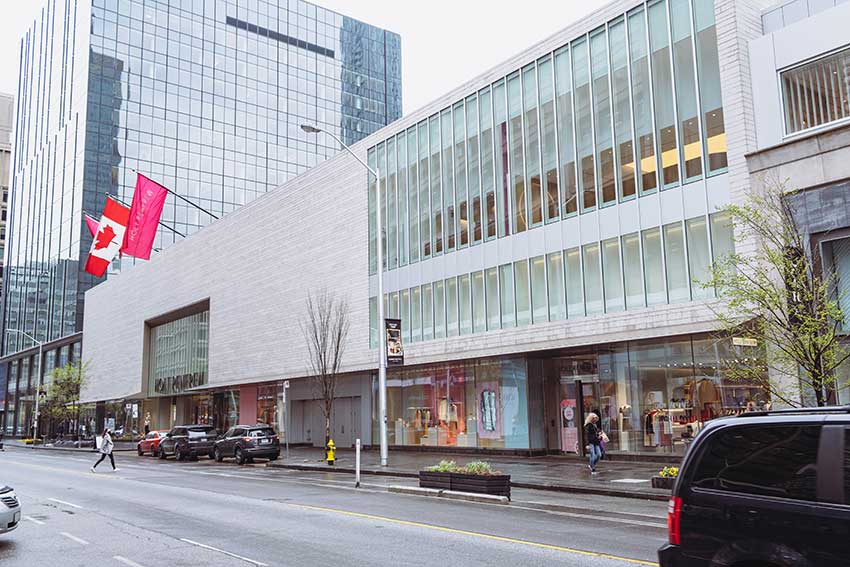Large Glass: An Evolving Choice for Quality, Stunning Facades and Interiors
Glass Color, Transparency, Tint, and Reflectivity
Large sheet glass, in both commercial and residential applications, is available in many colors. Specifying colored glass not only provides a decorative element but can also allow more or less light to enter a space. In addition to color, the architect can specify the percentage of transparency and reflectivity desired. How color and coatings are specified will be guided by the amount of privacy and light transmittance required, thus providing daylighting while managing glare. Light will vary by space, depending on window orientation, surrounding buildings and trees, and time of year. All of these factors should be considered when specifying large glass on exterior walls or ceilings. Ideally, the architect will specify glass, color, tint, and coatings in large glass applications to balance the need for additional shading devices.
Low-Emissivity Glazing
One of the most popular coatings in exterior applications is low-emissivity (low-e) glazing. A low-e coating consists of one or more thin layers of silver applied to the glass surface. It aids in reducing heat transfer from the outside and minimizes UV light that enters a space, providing additional comfort for occupants who want to experience the positive impact of daylighting without the negative impacts of UV exposure.
Heat gain and heat loss is measured through a U-factor, or U-value. This is the measurement of how effectively the glass can stop heat from passing through it. The use of low-e coatings allows building exteriors with large glass facades to have a lower U-value, which leads to better insulating properties and lower energy costs. Low-e glass contributes to the overall building system by helping to seal the building envelope. This prevents the HVAC system from over working to compensate for unwanted heat gain or loss. Consistent temperatures and humidity in a space lead to improved occupant comfort.
Protective Glazing
Impact Resistant
Impact-resistant glass utilizes laminated glass, which is created when two or more lites of glass are bonded together with an interlayer such as a clear thin film between the lites. This lamination helps hold the glass in place, making it more resistant to fallout. If the glass does break, any broken pieces will stick to the thin plastic film, which also helps keep out water, wind, and debris that could cause further damage to the structure.
Impact-resistant glass is especially beneficial in areas prone to natural disasters such as hurricanes, tornados, or earthquakes, allowing architects to specify large glass facades when properly designed for weather. Impact-resistant glass can also help prevent intrusion with proper glazing installation and anchorage of the framing to the wall. This type of glass can be a deterrent for those who attempt a smash and grab in a storefront.
Specifying Large Glass
When specifying large glass, heat-treated glass may be recommended because this process helps increase strength, increase the resistance to wind loads, and reduce the risk of thermal breakage. Tempered glass may be recommended because, if fractured, it will break into smaller pieces, making it less likely to cause serious injury. Tempered glass is often specified in sliding glass doors, building entrances, and room partitions, or as required by the building code.
While the standard thickness for regular glass lites is typically ¼ inch, it is recommended that larger sheets of glass be thicker to increase stability and durability. This can help the glass be secure within the frame, thus preventing the edges from pulling out of the frame over time and also preventing glass deflection. Extreme amounts of deflection can lead to distortion.
Both the manufacturer and fabricator should be consulted early and often to determine if the sizes specified can be properly and successfully fabricated for the job. This is especially relevant for large glass sheets that have unique shapes or sizes. Since most exterior large glass is installed in insulating glass units (IGUs), a wider than standard glass bite may be needed for larger sizes of sheet glass. The GANA Glazing Manual gives recommended minimum face and edge clearance and glazing bite for various glass thicknesses. Movement of the IGU can add stress to the IG seal and should be considered. Follow the recommendations of the glass manufacturer, fabricator or sealant supplier for individual instances.
During the specification process, prior to fabricating large glass products, architects and contractors may review visual mockups. The visual mockup helps to align the expectations of all stakeholders in a project, including the architect, building owner, and glazing contractor.
A mockup is a section of the exterior envelope, typically including portions of windows or curtain walls that are designed by the architect, comprising the exact components to be used in the final installation. Mockups can be built using materials that are full-size for the purpose of studying the construction details, testing performance, judging the appearance of the glazing and framing members to confirm installation sequencing, or other specific project goals. Large glass products installed in window and curtain wall applications can be challenging to handle or move. The size and shape of the large glass panels can create challenges during installation that are not always obvious, objective, or measurable. Mockups are especially helpful in these instances because they can be used to align the expectations of visual quality and performance in the presence of all key stakeholders before installation occurs.
Applicable industry standards should always be followed. Mockups can be used to fill in the gaps and to address concerns not explicitly covered by industry standards. Especially when installing large glass panels, visual mockups are recommended to ensure that the stakeholders agree before the products are installed on the building. Mockups should be considered standard practice, or benchmark targets rather than minimum standards.
After glass has been specified and manufactured, it must be inspected, packaged, transported, unpacked, inspected again, and installed.











